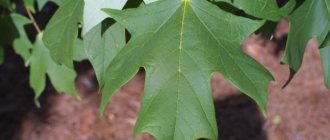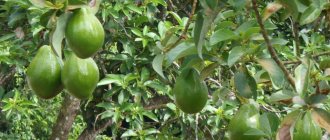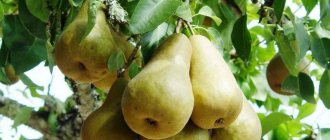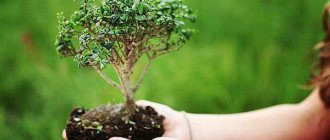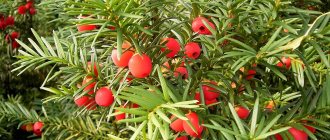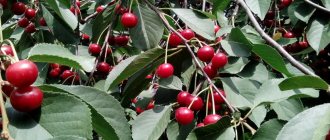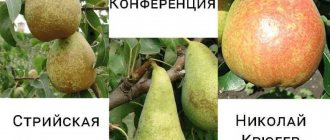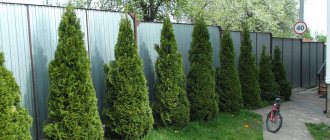Large-fruited strawberry tree or arbutus (Arbutus unedo) is an evergreen shrub or small tree from the Heather family.
In its natural environment, the plant is found in Morocco, Lebanon, Israel, Algeria, Asia, the countries of the Mediterranean basin and Western Europe. The pink-blooming subspecies A. unedo rubra was discovered in Ireland in 1835.
Culture is often mentioned in the works of poets and artists. The plant is depicted on the coat of arms of Madrid, and in the center of the city there is a sculpture of a strawberry tree and a bear feasting on its fruit.
The strawberry tree is quite unpretentious in care and can adapt to different growing conditions. Its relative, the small-fruited strawberry (Arbutus andrachne), blooms in winter, so in the middle zone you will not see its small strawberry-like berries.
Growing elderberry, types and varieties
This species is more unpretentious and can grow on poor and dry substrates.
Description of strawberry tree
Arbutus or Arbutus is a genus of trees and shrubs in the family Ericaceae. Its peculiarity is simultaneous flowering and fruiting, which begins in October and ends in February in some species.
Small pitcher flowers (up to 10 mm) of white and pinkish color bloom in drooping panicles of up to 30 pieces. Thanks to flowering, strawberries have a rich aroma.
Another feature of the plant is bisexuality, which implies the presence of both male and female organs and fruiting without a pollinator. However, the plant is also used as a honey plant.
The crop received its unusual name due to the external similarity of the fruits to strawberries. Although unripe ones have a green-yellow color, then orange and red, and the next year - after ripening, brownish-bloody. The rounded fruits of the strawberry tree are up to 20 mm in size, and seeds are found in the middle.
The height of the exotic is 10-15 m. The trunk girth is up to 90-100 cm. The culture is known for the fact that, unlike many other species, its dark gray wrinkled bark does not peel off. The wood is very durable and is used primarily as fuel.
The fluffy hemisphere-crown is quite impressive, especially since the foliage does not fall off all year round. A glossy dark green leaf blade from 0.4 to 1 cm in length and about 0.3 cm in width, elongated, jagged and slightly pointed, placed on long cuttings.
Why does the strawberry shed its bark?
At first glance at the tree, it seems that there is no bark on its trunks at all; in fact, it is there, but in an unfinished form. The upper cortical rough layer remains unformed in it. The annual renewal of the bark is a compensation for the function of photosynthesis. Like many other evergreen trees, arbutus experiences a period of so-called partial leaf fall, which usually occurs at the peak of hot summer. To save moisture, the plant reduces the evaporating surface and sheds the bark, which, when dying, no longer draws out vital juices, but partially covers the trunk from the sun. The young bark is green because it performs the function of photosynthesis at this stage.
How to grow a strawberry tree on a plot?
It is better to purchase strawberry tree seedlings in a pot with a whole ball of soil.
If you plan to grow in open ground, then you should take into account some nuances:
- The exotic is light-loving, but shade-tolerant. However, a location in absolute partial shade is not suitable. Warmth and sunlight are essential growth parameters for this genus of plants.
- Moderate temperature. Despite the fact that strawberry can withstand both +30 and -14 degrees C, it needs a temperature of +25 in summer, and up to +15 degrees C in winter.
- Watering is regular, but there is no need to fill it. It is better to navigate by the soil itself - if it is already dry, then moisten it a little. It is advisable to spray the leaves. The plant is drought-resistant and if you have to choose between two evils, it is better to add too little water than to provoke putrefactive processes.
- The soil is nutritious and well-drained, although it will also tolerate heavy clay soils. Acidic soil is also not a problem. But it is better to use limestone, light sandy or medium clay.
- Does not tolerate wind and drafts. But in extreme heat it is necessary to ensure ventilation of the space.
An unpretentious tree or shrub can be grown in a winter garden, in a greenhouse, and even on a windowsill in the form of a bonsai.
Growing
Arbutus is a plant with average frost resistance. The most optimal summer temperature for it is within +25-30°C. In winter, the temperature may drop, but not below -12°C. If the air temperature drops below, then strawberry inflorescences, young shoots, and leaves may freeze. Therefore, in our country, strawberry trees can only be grown in gardens and parks in the south.
Planting seeds
In all other regions it is grown indoors, which means sowing can be done all year round. Before planting the seeds, it is necessary to stratify them: the planting material is placed in a mixture of peat and river sand in a ratio of 7:3 and kept for 2 months in the refrigerator, in the vegetable compartment. Then they are kept in water at room temperature for about a week. Then they are slightly dried and embedded in the soil to a depth of 1-2 cm. Shoots should appear only after 2 months, during which time the soil must be periodically moistened.
In summer, the plant can be brought outside. In winter, it is kept at a relatively low temperature indoors: in a room, greenhouse, winter garden or on a heated balcony.
Growing strawberries from seeds is not very difficult, but it will require a significant investment of time. But it can also be propagated by cuttings. True, this is a rather complex process that requires certain knowledge and skills. For this method, in June-July or autumn, semi-lignified young shoots 8-10 cm long are cut or root cuttings are used, which are harvested in the first days of spring. To increase their ability to root, they are kept in a solution with the addition of a growth stimulant, and then planted in a greenhouse. When growing plants from young shoots, they are covered with glass jars and transparent plastic bottles.
Rooting usually takes about 1.5 months. During this period, it is necessary to maintain air and soil humidity at a high level in the greenhouse. After a small root system (4-5 roots) is formed, the seedling will begin to grow. When the growth is 5 cm, it can be transplanted to a permanent growing location. If strawberries are to grow in the garden, then the young plant must first be hardened off. To do this, they are taken out of the greenhouse into the air for several days.
Selecting a location
Strawberries grow well in any soil. But if the gardener has a choice, then it is better to plant seedlings in acidic soil in a well-lit area. Despite its resistance to drought, arbutus also tolerates moderate watering.
Planting seedlings
When grown in open areas, when used in landscape design, seedlings are planted at a distance of about 3 m from each other, after 6-8 young leaves appear on them. In order not to damage the fragile root system of the strawberry, you need to be careful when carefully removing the plant from the pot along with the earthen lump and carefully placing it in the prepared planting hole. After compacting the soil around the stem and watering the plant with water, the surface of the soil is mulched with pine needles and small stones, which will prevent rapid evaporation of moisture and help maintain the required level of acidity.
Care
Exotic arbutus is not picky. Caring for it is quite simple and does not require large investments of labor. If the plant is kept indoors (greenhouse, greenhouse), then it must be ventilated occasionally. In addition, the following activities will need to be carried out
- Watering
- Top dressing
- Crown trimming
- Wintering
- Tinctures and decoctions of flowers help cope with diseases of the mouth and throat.
- Preparations from the leaves have proven themselves in the treatment of diseases of the gastrointestinal tract and digestive organs.
- Medicines made from the roots and bark of the strawberry tree are used externally to treat wounds, burns, and dermatological diseases.
Watering should be done regularly, especially during the growing season and at the time of fruiting. To do this, use soft, settled water. Very frequent and excessively abundant watering can cause rotting of the roots and the appearance of dark spots on the leaves. If the arbutus sheds its leaves, it means it lacks moisture. In this case, the frequency and intensity of watering must be increased. You can also spray the crown of the plant with water.
Organic and mineral fertilizers are applied only in the spring and summer, when the plant is growing vigorously. As a top dressing, which should be done at least twice a month for young trees and once a quarter for old trees, you can use compost or special fertilizers for heather plants. During the cold season, only those plants that are kept indoors are fed.
Arbutus grows slowly, and its branches bend very whimsically, so the formation of the crown is carried out very rarely, as needed. To do this, in the spring, branches that reduce the decorativeness of the plant are removed. Sanitary pruning is also carried out in spring and autumn. In this case, remove dry, damaged branches and shoots by carefully cutting them off with sharp pruning shears.
In winter, regardless of whether strawberries are grown in open or closed ground, they need to be provided with rest. To do this, the air temperature is reduced to 11-15°C. If the arbutus grows outside, then it is covered and protected from the cold wind.
Diseases and pests
Improper care, in particular too much watering, can lead to fungal diseases. The first symptom of the disease is brown spots that appear on the leaves. In this case, you should carefully examine the plant, collect the affected leaves and burn them, and carefully treat the tree itself with fungicides.
Increased soil moisture can lead to another problem: the appearance of pathogens on the roots. The only way to prevent the infection from spreading to other plants is to remove the affected tree. Overmoistening can also lead to other diseases - late blight, anthracnose, rust. For “treatment” special drugs are used.
But the spider mite, which can settle on a strawberry tree, on the contrary, does not like high humidity. In this case, the plants can be treated with a special pest control agent, a soap solution.
Sometimes gardeners who grow strawberries indoors are faced with the fact that fruits do not form on flowering plants. The reason is most likely the lack of pollinating insects. In this case, artificial pollination can be carried out by transferring pollen with a brush.
Culture propagation
There are two propagation options: seeds and cuttings. Purchasing seedlings is quite problematic due to the exotic nature of the plant for our region.
Cuttings from woody parts of the plant are ineffective. It takes a long time to propagate a strawberry tree from seeds, but it is not as difficult as it seems at first glance. Stages:
- Buying seeds or fruits. Carefully remove the seeds from the fruit and wash them. Dry seeds must be pre-soaked.
- Stratification. Seeds are planted in moist soil at a depth of 10 mm, covered with plastic film and for 3 months. placed in a refrigeration device.
- Place it on a window on the north side (but without exposure to ultraviolet rays), where there is light, but not hot.
- Wet the soil when dry.
- Picking pars with 5 leaves with a complete lump of soil.
- The appearance of the 8th leaf is a sign that the plant is ready to be transplanted to a permanent location.
The soil can be either ordinary garden soil or a mixture (peat-sand with pine needles). The most successful option is to take soil from under an adult, well-flowering plant. Feeding is required only until the 3-4th year of life with organic substances a couple of times a year.
The Arbutus strawberry tree is easy to care for, but propagation is a labor-intensive process. Branches, for example, take root within 2 years. Shoots are selected only from the current year and with signs of lignification. Planting in late autumn or early winter involves the use of root formers.
Use in folk medicine
Traditional healers use all parts of the strawberry tree. The raw materials are collected in the summer, dried under a canopy or on dryer trays, turning them over every day. Dried arbutus gifts are stored in paper bags for no more than 2 years. Homeopaths use raw materials for inflammation of the bladder and urethra, skin diseases accompanied by itching and the appearance of blisters, pustules, scales, and problems of the digestive tract.
Decoctions and tinctures are used for diseases of the ears, nose and throat, and damage to the oral mucosa.
The plant extract is used as a remedy that reduces the tone and motor activity of smooth muscles, relieves inflammation and increases the rate of urine formation.
Pharmacological properties
The chemical composition of arbutus has been little studied. It is known that the fruits of the plant contain organic acids, polysaccharides, and sugars. Overripe fruits contain 0.5% alcohol. The bark and leaves contain polyphenols, tannins, and the toxic glycoside Rhodotoxin.
Use in medicine
For a long time, an extract from the plant was used as a medicine for highly infectious epidemic diseases. Arbutus has the properties to prevent decomposition processes on the surface of open wounds and increase the rate of urine formation. An infusion of the leaves of the culture relieves involuntary contractions of the stomach muscles and restores the physiological functions of the intestines. The decoction is used externally, applying bandages to damaged skin areas and burns.
Contraindications
Treatment with arbutus-based drugs is contraindicated for pregnant and lactating women and children. An excess of plant berries can cause migraines and indigestion.
Where does the strawberry tree grow?
This plant has a huge distribution area. Starting from Canada, America and Mexico to Libya and Turkey. Although it originally grew in Ireland (under the name cane apple), France and the Mediterranean. Arbutus is quite ancient. Archaeologists find its remains. The strawberry tree was brought to us from Brazil, where it grows in the northeastern part of the coast, and has spread throughout South America. The bear and the strawberry tree have been symbols of Madrid since the 13th century. Now the plant has been actively used in landscaping in Great Britain since the 16th century. The exotic came to our lands in the 19th century.
Optimal conditions for home and garden breeding
The requirements of a home earthen tree are usual - it needs a room temperature of about +25C, enough diffused light (direct sun is undesirable), moderate watering and winter dormancy. It should also be noted that it does not tolerate drafts well. In the garden, a semi-shaded place without close water and protected from the winds is suitable for him.
Varietal diversity
There are 11 species of strawberry in total. They can be divided into two groups according to their place of natural growth: Mediterranean and American-Mexican. The first includes the following crops.
Arbutus andrachne (Red or Greek Arbutus)
Natural habitat - Middle East. Grows up to 12 m in height.
A distinctive feature is the wood that is bare and has a slight bloody tint.
Large-fruited strawberry tree (Arbutus unedo)
There are several variations of the type: Compacta – up to 2 m; slow-growing Croomei and Rubra with pink flowers; large-fruited pot Elfin King;
Photo of Arbutus unedo
A hybrid of Arbutus × andrachnoides, which has absorbed all the best from large- and small-fruited strawberries: with a large leaf blade and large fruits.
Those strawberries that grow in America, Mexico and Ireland are more recognizable. Among these varieties the following can be noted:
Photo of Arbutus xalapensis in Mexico
- Texan Arbutus xalapensis (up to 25 meters in height);
- Mexican shrub Arbutus tessellata;
- horizontally growing shrub Arbutus occidentalis;
- Mexican Arbutus madrensis.
All of them have their own characteristics and some are more unpretentious in care and temperature conditions, others have their own specific requirements.
Problems
The strawberry tree is unpretentious to conditions and is little susceptible to diseases, but sometimes they still appear:
- Regular overwatering can lead to the formation of fungus on the foliage - it becomes covered with brown or brown spots;
- The most common pest is the spider mite, which attacks the bark of the plant.
For the most part, the Strawberry tree suffers from frosts in early spring, when it is taken out into the open air, and frosts occur at night. Wood is very heat-loving, this must be taken into account.
Strawberry tree: the benefits and harm of berries
Is it possible to eat the fruits of the strawberry tree? This is a valid question for everyone who has children and animals in their family. The visual similarity and aroma of strawberries, as well as some similarities in taste, make it attractive. Tannin gives the berries a certain piquancy. And the content of 20% sugars is sweetness.
The fruits are also rich in vitamin C. However, there are also contraindications:
- Only fully ripened berries can be eaten without rotting as a result of falling and/or long-term storage;
- going overboard with the quantity is just as harmful as eating unripe fruits - allergies, diarrhea, and signs of poisoning may appear.
Arbutus can be eaten raw or prepared into a dish or drink. They also make preparations for the winter from it.
The taste of the fruits of the strawberry tree is specific. Some people like it like a pear, others don't like it at all. But this is a quite useful plant. Even its foliage is used for tanning leather, making fiber treatants with tannin, and for medicinal purposes. The barrel has been used by pharmacists since the time of the raging plague in Europe. Cosmetologists actively use the plant for their skin care products. But you need to keep in mind that the andromedotoxin present in strawberries, for example, does not dissolve during processing. Therefore, berries are not recommended for pregnant women, lactating women and small children.
Usage
Bees process pollen from strawberry flowers into bitter honey. Wine and aromatic vodka are prepared from the berries, jam, candied fruits, and syrups are made. Eat fresh, but in small doses. But this does not apply to strawberries, which are grown in an apartment. It serves rather a decorative function.
An extract from parts of the plant is used to process and dye leather. It contains a substance called tannin, which not only imparts astringency to the leaves, but also repels animals that try to eat the stems of the plant.
In medicine they are used to treat diseases of the urinary system and to protect against microbes.
The wood is off-white in color and does not rot. It is highly valued and is used to make gift boxes.
An interesting feature of strawberry wood: it is poorly resistant to fire. Therefore, the strawberry tree is used in areas where it grows to restore forests after a fire.
The calorie content of the fruit is about 30 kcal. But there is evidence that, consumed in large quantities, they act like dope. They give me a lot of headaches. Unripe fruits cause nausea and vomiting.
